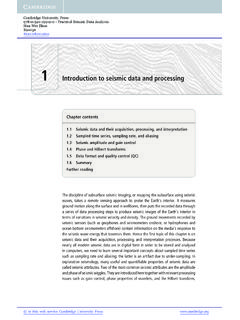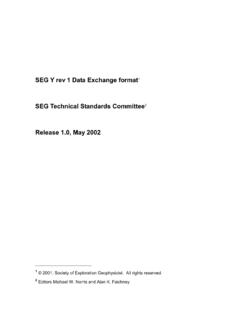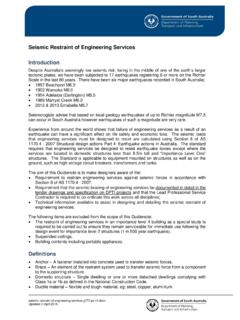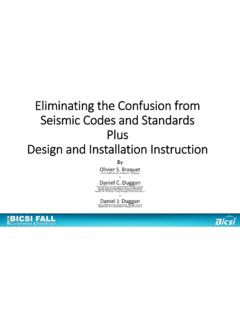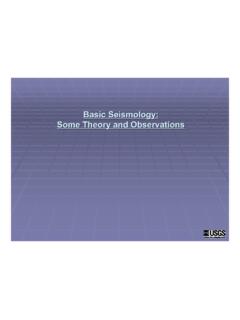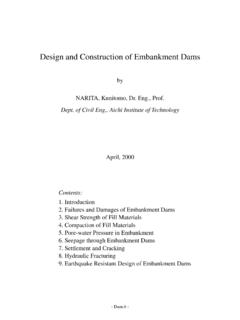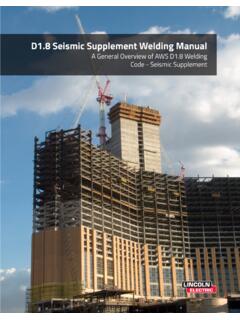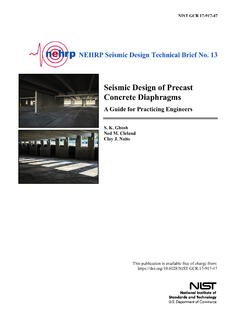Transcription of STRUCTURAL MODELING NOTES PART 1 - USING ETABS
1 STRUCTURAL MODELING NOTES Date: JULY 2019 Rev.: Prepared by: Dr. Mahmoud El-Kateb P a g e | 1 STRUCTURAL MODELING NOTES PART 1 - USING ETABS STRUCTURAL MODELING NOTES Date: JULY 2019 Rev.: Prepared by: Dr. Mahmoud El-Kateb P a g e | 2 TABLE OF CONTENTS 1. INTRODUCTION .. 5 2. DEFINE MATERIAL PROPERTIES .. 5 3. DEFINE SECTION PROPERTIES .. 7 4. DEFINE DIAPHRAGMS .. 9 5. DEFINE RESPONSE SPECTRUM FUNCTION .. 10 6. DEFINE MASS SOURCE .. 13 7. DEFINE P-DELTA OPTIONS .. 14 8. DEFINE MODAL CASES .. 15 9. DEFINE LOAD PATTERNS .. 16 10. DEFINE LOAD CASES .. 22 11. DEFINE LOAD COMBINATIONS .. 23 12. DEFINE AUTO CONSTRUCTION SEQUENCE CASE .. 23 13. ASSIGN 24 14. ANALYZE MENU .. 26 15. DESIGN PREFERENCES.
2 28 16. POST ANALYSIS CHECKS .. 31 17. IMPORTANT NOTES ON LATERAL DRIFT RESULTS .. 33 18. COMPUTING P-DELTA EFFECT .. 34 19. COMPUTING TORSIONAL AMPLIFICATION .. 42 20. COMPUTING THE LATERAL DRIFT .. 45 PART 2 - USING SAFE .. 50 1. INTRODUCTION .. 51 2. DEFINE SOIL SUBGRADE PROPERTIES .. 51 3. DEFINE POINT SPRING PROPERTIES .. 51 4. DEFINE LOAD CASES .. 52 5. DEFINE LOAD COMBINATIONS .. 57 6. RUN > CRACKING ANALYSIS OPTIONS .. 58 7. PUNCHING SHEAR DESIGN .. 59 8. DISPLAY CRACK WIDTH .. 60 9. IMPORTANT DIFFERENCES BETWEEN ETABS AND SAFE .. 62 PART 3 - USING SAP2000 .. 63 1. INTRODUCTION .. 64 2. DEFINE JOINT PATTERNS .. 64 3. ASSIGN JOINT PATTERNS .. 64 4. ASSIGN AREA LOADS > SURFACE PRESSURE .. 66 5. DISPLAY LOAD ASSIGNS > AREA .. 67 REFERENCES.
3 68 STRUCTURAL MODELING NOTES Date: JULY 2019 Rev.: Prepared by: Dr. Mahmoud El-Kateb P a g e | 3 LIST OF FIGURES Figure 1 Define concrete material property data .. 5 Figure 2 Definition steel rebar material property .. 6 Figure 3 ASCE 7-10 response 10 Figure 4 UBC97 response spectrum .. 11 Figure 5 EUROCODE8-2004 horizontal response spectrum .. 12 Figure 6 EUROCODE8-2004 vertical response spectrum .. 13 Figure 7 Mass source data .. 13 Figure 8 P-Delta options in ACI, BS and ECP .. 14 Figure 9 Modal case data .. 15 Figure 10 Load patterns .. 16 Figure 11 Wind load pattern in ASCE 7-10 .. 17 Figure 12 Wind load pattern in BS 6399-95 .. 18 Figure 13 Seismic load pattern in ASCE 7-10 .. 19 Figure 14 Seismic load pattern in UBC97.
4 20 Figure 15 Seismic load pattern in EUROCODE8-2004 .. 21 Figure 16 Response spectrum load case .. 22 Figure 17 Default design combinations .. 23 Figure 18 Auto construction sequence load case .. 24 Figure 19 Wind pressure coefficient .. 26 Figure 20 Check model check list .. 27 Figure 21 Concrete frame design preferences .. 28 Figure 22 Shear wall design preferences .. 29 Figure 23 Concrete slab design preferences .. 30 Figure 24 Check box to display modal response .. 31 Figure 25 Structure period and mass participation ratios .. 31 Figure 26 Check box to display base reactions .. 32 Figure 27 Base vertical and seismic reactions .. 32 Figure 28 Entering scale factor .. 33 Figure 29 Pile spring property data .. 51 Figure 30 STD Load 52 Figure 31 Case2 Load case.
5 53 Figure 32 LTD Load case .. 54 Figure 33 STDD load case .. 55 Figure 34 Non-linear case for up-lift .. 56 Figure 35 Long Term Deflection Load combinations .. 57 Figure 36 Options for cracking analysis .. 58 Figure 37 Punching shear ratio display .. 59 Figure 38 Punching shear design overwrites .. 59 Figure 39 Punching shear design RFT .. 60 Figure 40 Crack width dialogue box .. 61 Figure 41 Assign joint pattern data .. 65 Figure 42 Assign area surface pressure 66 Figure 43 Area surface pressure display .. 67 STRUCTURAL MODELING NOTES Date: JULY 2019 Rev.: Prepared by: Dr. Mahmoud El-Kateb P a g e | 4 LIST OF TABLES Table 1 Concrete modulus of elasticity .. 6 Table 2 Maximum yield strength to be used for rebar.
6 7 Table 3 Property modifiers for beams .. 7 Table 4 Property modifiers for slabs .. 8 Table 5 Property modifiers for shear walls and cores(Ref. 1) .. 9 Table 6 Use of null frames and null shells with diaphragms .. 9 Table 7 Calculating modulus of rupture .. 58 Table 8 Differences between ETABS and SAFE(Ref. 8) .. 62 STRUCTURAL MODELING NOTES Date: JULY 2019 Rev.: Prepared by: Dr. Mahmoud El-Kateb P a g e | 5 1. INTRODUCTION The main objective of this manual is to set a guideline to be followed by STRUCTURAL design team during phases of STRUCTURAL MODELING USING CSI software ( ETABS ), and STRUCTURAL analysis. This manual contains parameters, procedures and recommendations concern mostly about reinforced concrete structures and that comply with the CSI manuals and technical papers as well as the common design codes as listed hereafter; American: ACI 318-14 ASCE 7-10 Eurocode: EC2; EN 1992-1-1:2004 EC8; EN 1998-1:2004 British: BS 8110-1:1997 & 2:1985 BS 6399-1&2&3 Egyptian: ECP 203-2007 ECP 201-2012 The recommendations and procedures in this manual are following the most common standard practice in the region.
7 However, in some cases or in certain projects, some parameters and/or procedures may be revised. 2. DEFINE MATERIAL PROPERTIES CONCRETE The defined concrete should be named as the concrete grade (for example fcu50 or fc40 ) as shown in Figure 1. Figure 1 Define concrete material property data STRUCTURAL MODELING NOTES Date: JULY 2019 Rev.: Prepared by: Dr. Mahmoud El-Kateb P a g e | 6 The following parameters are used for all design codes unless otherwise mentioned in project specifications: Specific weight density = 25 kN/m3 = ton/m3 Poisson s ratio = The following parameters are according to the design code: Table 1 Concrete modulus of elasticity Parameter ACI 318 EC2 BS 8110 ECP 203 Modulus of Elasticity (E) in MPa 4700`cf(a) 22000[(fck+8)/10] (b) 1000*(20+ *fcu)(c) 4400cuf(d) Specified concrete compressive strength(e) fc` fck = fc` fcu fcu Where fc` = fcu for fcu < 60 MPa (a) ACI 318-14; clause (b) EC2; EN 1992-1-1:2004; clause (c) BS 8110-2:1985; clause (d) ECP 203-2007.
8 Clause (e) When the design code in concrete frame design preferences is changed to ACI 318 or BS 8110, the specified concrete compressive strength option is automatically changed to fc` or fcu, respectively, but without changing the entered value. STEEL REINFORCEMENT The steel reinforcement rebar should be defined according to Figure 2, while the maximum yield value used for bending and shear reinforcement should be limited as listed in Table 2. Figure 2 Definition steel rebar material property STRUCTURAL MODELING NOTES Date: JULY 2019 Rev.: Prepared by: Dr. Mahmoud El-Kateb P a g e | 7 Table 2 Maximum yield strength to be used for rebar Design action ACI 318 EC2 & BS 8110 ECP 203 Bending 460 MPa or 420 MPa(a) 460 MPa 400 MPa Shear and punching 420 MPa(b) 460 MPa(c) 400 MPa(d) (shear) 350 MPa (Punching) (a) ACI 318-14; clause , for special seismic system (b) ACI 318-14; clause , for shear and torsion (c) BS 8110-2:1985; clause, (d) 240 MPa for 8mm diameter stirrups and 400 MPa for 10mm or more diameter stirrups 3.
9 DEFINE SECTION PROPERTIES FRAME SECTION FOR BEAMS Beams are usually modeled as concrete rectangular section. The section should be named after the concrete cross section (for example B300x700 ). The property modifiers are according to Table 3. Parameters in Reinforcement section: Design Type: M3 Design Only (Beam) Cover to rebar: 50 mm is used for top and bottom bars Table 3 Property modifiers for beams Property ACI 318 EC2 BS 8110 ECP 203 Torsional constant (a) Moment about 2 axis Moment about 3 axis (b) (c) (a) ECP 203-2007; clause , for cracked beam section carrying equilibrium torsion. While could be set to where compatibility torsion is needed to be redistributed. (b) ACI 318-14; clause , for T-sec simple beam, use modifier = and for continuous beams with T-sec parts, use modifier = (c) ECP 201-2012; clause , T-sec simple beam, use modifier = and for continuous beams with T-sec parts, use modifier = STRUCTURAL MODELING NOTES Date: JULY 2019 Rev.
10 : Prepared by: Dr. Mahmoud El-Kateb P a g e | 8 FRAME SECTION FOR COLUMNS Columns are usually modeled as concrete rectangular or circular section. The section should be named after the concrete cross section (for example C3-300x700 ). The property modifiers are used as for moment of inertia about 2 and 3 axes as well. Parameters in Reinforcement section: Design Type: P-M2-M3 Design (Column) Check / Design: Reinforcement to be designed in the first run to determine the required reinforcement ratio then Reinforcement to be checked in later runs after entering the column chosen reinforcement distribution. Clear Cover to rebar: 30 mm for ECP and BS, while 40 mm for ACI SLAB SECTION FOR SLABS Solid, flat, drop panels and post tension slabs ( ) are usually modeled as shell-Thin section.
